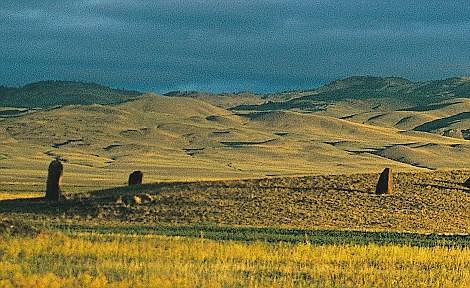Discovered archaeological ruins of Aryan civilization
The Bronze Age cities built by the Aryans were started in the Western civilization of Europe, recently discovered in a remote area of Russia.
Archaeologists have identified the archaeological archaeological sites of 20 archaeological sites , which have been built around 4,000 years ago, only a short time after the construction. The Great Pyramid of Giza in Egypt was completed. Archaeologists believe that these housing complexes were probably built by the lineage of ancient Aryans, who worshiped the swastika symbol and then the Nazis headed by Hitler chose the symbol. of the Aryan people symbolize their party in the 1930s.

Bronze-era cities were built about 4,000 years ago by the ancient Aryan lineage, stretching up to 400 miles along the Russian steppe.
TV historian Bettany Hughes surveyed the desolate enclave of the Russian steppe bordering the Republic of Kazakhstan border in the summer of 2010, in the hit television program ' Following the Aryan Man ' BBC Radio 3. Ms. Bettany Hughes said: ' It is very likely that the newly discovered architectural complexes have a relationship with the ancient Greek civilization in the era of heroes . Because I have written many books related to the Bronze Age world, there is a large treasure of fragments of the jigsaw games present here. We all think it is the expression of the native language, the original Indo-linguistic linguistic family, from all the languages we know. I was very excited to hear archaeologists say that they found a secret information system from which deciphering the Bronze Age civilization was discovered on the steppe in southern Siberia . '
The traces of this ancient city were first discovered 20 years ago, shortly after Soviet officials eased the ban on taking photos from space of the demilitarized forces. . But because the location of the ancient cities was located in a remote, remote place, it seemed to be forgotten for the rest of Europe until recently. Those spiraling lands are about the same size as some ancient Greek cities, each of which is a home for between 1,000 and 2,000 people.
Mrs. Bettany Hughes pointed to this vast land at the invitation of the archaeological team leader, Professor Gennady Zdanovich, aiming to see the cities buried beneath the wild steppe underground. The Aryan language has been identified as the pioneering language of modern European languages. In the English language, words like ' brother ' or ' brother, brother ', ' oxen ' or ' cow ' and ' guest ' or ' guests ' originated from the language were used. Aryan.
People also excavated at these archaeological sites some artifacts such as makeup tools, a horse cart and many ceramic fragments. These objects were spread on the swastika symbol, perhaps they were used as symbols of the Sun and eternal life. But the swastika and the Aryan line were recognized by Hitler and the Nazis as a divine symbol and claiming to be descendants of the superior Aryan lineage.
Traces of sacrificial burial sites were also found in ancient documents of the ancient Aryan , which depicted animals that were chopped into pieces and buried with the owners. its core.
Ms. Bettany Hughes from King's London College added: ' Professor Zdanovich has brought me to this vast archaeological site; I'm not sure what to say about special things there. Then he instructed me about things on the surface of the landform, I was really surprised to learn that I was walking on an ancient city that was buried. Now I can visualize fortresses, castles and houses and other important religious monuments. I could not have known that place if Professor did not show me well. English books and hymns - Ancient Temples described horse sacrifices and burial areas, in which horse meat was cut into pieces and they were buried with the owners. . This is a very interesting archaeological discovery '.
- Beer helps civilization grow faster
- Discovery of architectural ruins 1,400 years ago
- Discovered a 4,300-year-old jade disc in China
- Old satellites discovered thousands of ancient monuments
- Phat found a mass grave of mummies
- Discovering 1,000-year-old Cham Pa ruins
- Discovered ancient Greek fortress in Jerusalem
- Find the legendary city of civilization that has mysteriously disappeared?
- Discover and excavate many archaeological archaeological sites of the Stone Age
- Discovered collective grave of Inca civilization in Peru
- Discovered two ancient tombs in Maya civilization in Guatemala
- Egypt discovered the ruins of the ancient city of Memphis
 Discovered an ancient centipede fossil 99 million years old
Discovered an ancient centipede fossil 99 million years old Discovered bat-like dinosaurs in China
Discovered bat-like dinosaurs in China Discovered a 200-year-old bronze cannon of the coast
Discovered a 200-year-old bronze cannon of the coast Discover 305 million-year-old spider fossils
Discover 305 million-year-old spider fossils